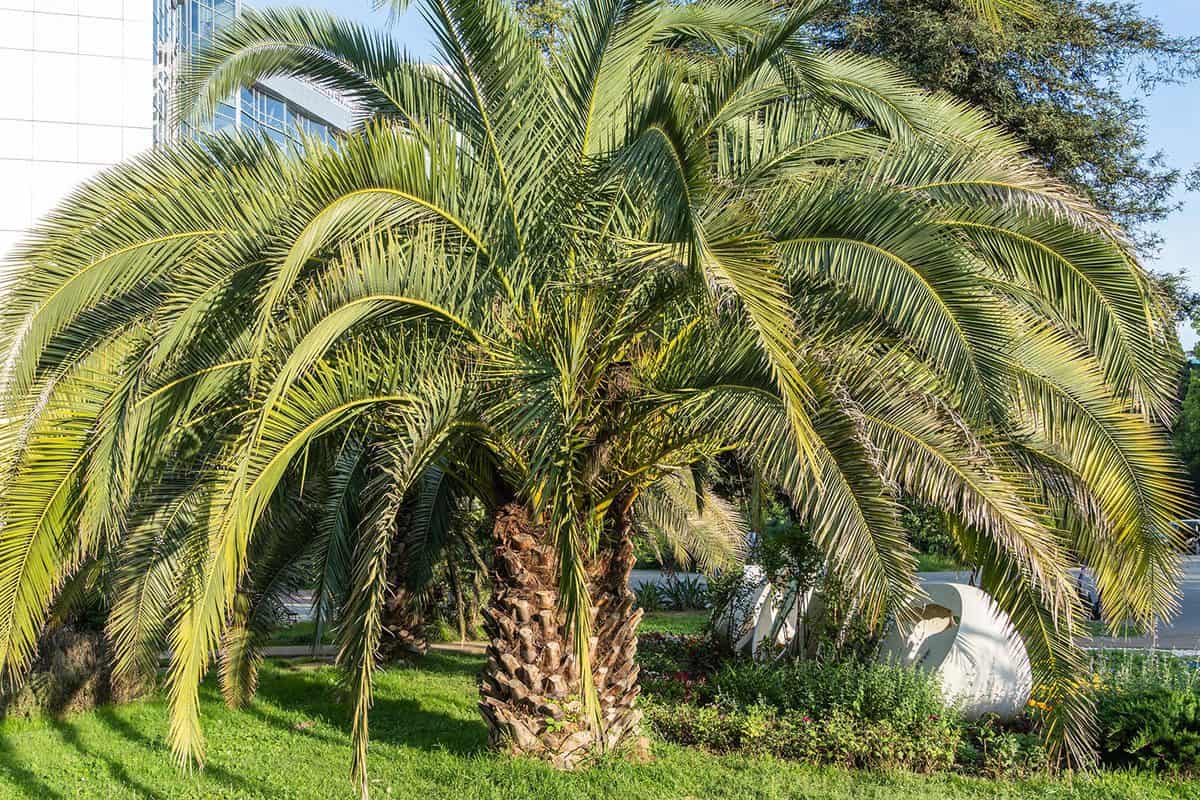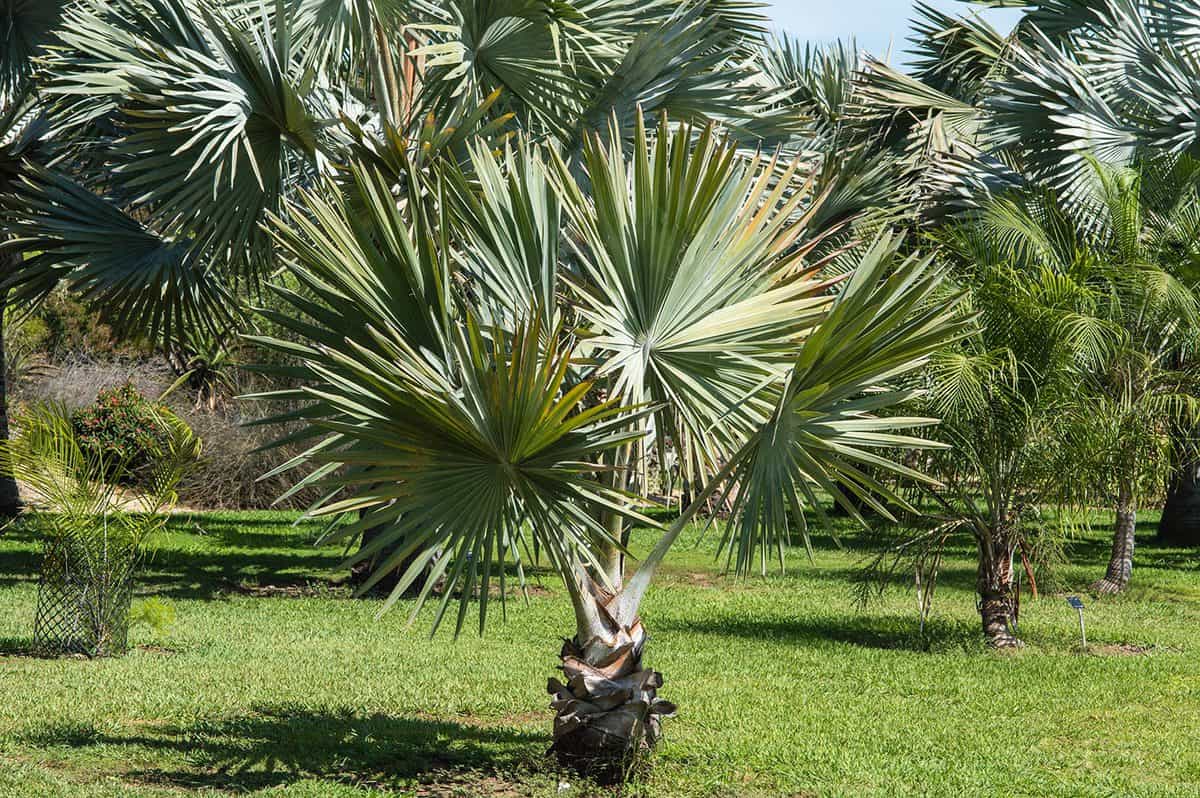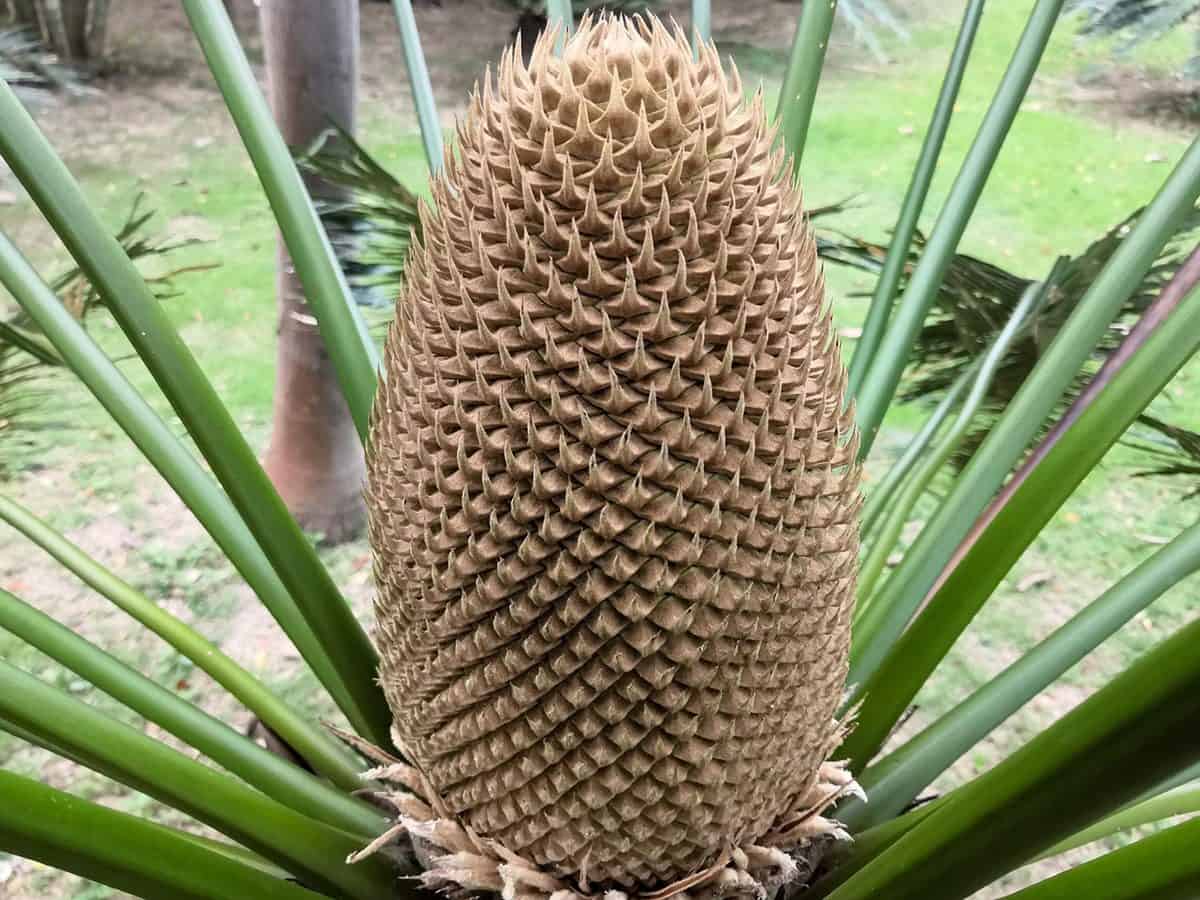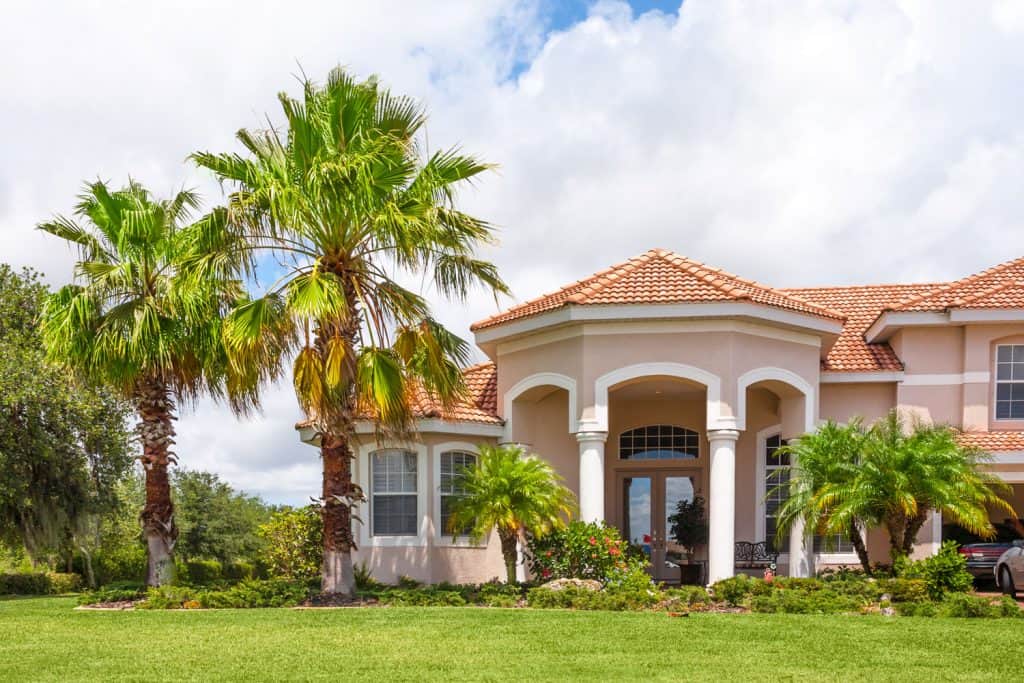It's not always easy to make your landscaping pop. Luckily, palm trees stand out in just about any yard. You don't have to let these types of trees run willy-nilly all over your property, though. When in doubt, why not consider planting your preferred palm tree in a sizeable pot?
Most palm trees are hardy and adaptive, meaning that they can thrive in a wide variety of settings. So long as you provide these trees with adequately-sized pots, you'll be able to move them about at your leisure, all without worrying about what kind of impact the roots might have on the structural integrity of your home.

What Palms Can Be Grown In Pots Outdoors?
Not every palm will thrive when planted in a pot. If you're looking for a good starter palm tree to place in a pot or other planter, you can choose from any of the following:

1. Chinese Fan Palm (Livistona chinensis)
Also known as the fountain palm, Chinese fan palms are considered to be among the best starter palms for gardeners looking to add a bit of flair to their front walks. If you live in an area with tighter soil or with inconsistent rain patterns, you're in luck. The Chinese fan palm is renowned for its durability and can stand up to both drought and cold without losing its vigor.
Once mature, the Chinese fan palm can grow to be forty feet fall with a twelve-foot spread. These palms do best when exposed to full sunlight and slightly acidic soil. You'll have the best luck bringing these palms up to their fullest capacity in hardiness zones 9 and 10.
When it comes to growing these types of palms in pots, you'll be able to keep your container small for the first few years of the palm's life. However, as it grows, be prepared to transplant your Chinese fan palm to compensate for its root growth.
2. Jelly Palm (Butia capitata)

Jelly palms are stouter than they are tall, but that doesn't mean that they won't make a stately addition to your front walk. The palms of the jelly palm tend to weep downward, ensuring that they demand attention while also providing your lawn with shade.
Another hardy palm tree, jelly palms can stand up to salt, heat, and drought without faltering. While it's not in your best interest to grow these palms in colder regions, you'll be able to see a potted jelly palm come into its own so long as it stays about 14 degrees Fahrenheit.
As mature adults, jelly palms will cap off at twenty feet tall and fifteen feet wide. These palms do best in well-draining soil and when they have access to full sunlight. You'll want to make sure that the pot you have on hand for your jelly palm can compensate for the palm's natural stoutness, not to mention its extensive root growth.
3. Silver Saw Palmetto (Serenoa repens)
Most often found in Florida and similar regions, silver saw palmetto palms have a better chance of surviving in cooler zones than most other palms. Another especially-hardy palm tree, you can count on these palms not only to last through some of the colder months of the year but also to add a spiky pop to your landscaping plans.
Silver palms tend to grow wider than they do tall. You'll most often find these palms spreading twenty feet across while their heights cap off at eight feet. As mentioned, these palms can also stand up to unforgiving conditions. They not only resist the cold, but they are salt and deer tolerant, as well. While not technically drought-tolerant, these palms do not require all that much water to thrive, either. So long as you invest in a wide pot, you'll be able to cultivate these palms in any hardiness zone between 7 and 10.
4. Mexican Blue Palm (Brahea armata)
Worried about how the summer's heat might impact the health of your potted palm? Mexican blue palms are as heat-resistant as palm trees come. The beautiful silver fronds that these palms boast can fan out over your yard in even the hottest of summers.
Mexican blue palms grow best in USDA Plant Hardiness Zones 9 through 11. They prefer loamy and sandy soils, but they can also thrive when planted in well-draining pots. These palms are among the taller potted palms you can have around your home, growing to a maximum height of forty feet when well-cared for.
That said, Mexican blue palms are particularly rare. If you want to add one to your landscaping, you'll want to reach out to the professionals at your local nursery for guidance.
5. Adonidia (Veitchia merrillii)
Also known as Christmas palms, adonidia palms are on the smaller side when it comes to potted palms. That said, these ornamental additions to your front lawn will catch the eye of just about any passerby.
Adonidia palms tend to grow best in hardiness zone 10 or above when temperatures don't drop below 32 degrees Fahrenheit. These palms tend to grow more slowly than their cousins and don't often grow past fifteen feet in height. The good news is that, like many other potted palms, a Christmas palm is relatively low-maintenance. Most adonidia palms are also self-cleaning, as you can see in this video:
6. Bismark Palm (Bismarckia nobilis)

All of the palms noted here can fit well in pots. When it comes to the bismark palm, though, you'll want to go into your initial shopping prepared for some significant growth. Bismark palms are among the tallest of the potentially-potted palms. These palms top out at sixty feet tall when well-cared for. Their spreads alone can grow to be sixteen feet in length.
Bismark palms grow best between hardiness zones 10 and 11. Unlike many of their cousins, these trees are a little more sensitive to cooler temperatures; exposure to freezing weather can severely stunt their growth. Like most palms, though, bismarks prefer full sun access and will thrive when planted in well-draining soil. Just be prepared, upon introducing a bismark to your front lawn, for it to become the main attraction not only near your home but up and down the entire block.
7. Lipstick Palm (Cyrtostachys renda)

Want to add a pop of color to your garden? Lipstick palms stand out compared to other varieties thanks to their thin build and their trunks' bright red coloration.
That said, these palms can be a little more temperamental than some of the other palms that thrive in pots. To see a lipstick palm take proper root around your home, you'll need to live above USDA Plant Hardiness Zone 10. Similarly, you'll want to make sure that your lipstick palm is never exposed to temperatures below 40 degrees Fahrenheit, or else you'll end up stunting the palm's growth.
Lipstick palm trees can grow to be exceptionally tall when well-cared for, topping out at fifty feet when exposed to the best climate possible. More often than not, however, these palms will stop growing once they've hit thirty feet, making them an excellent statement piece in any front yard.
8. Chesnut Dioon (Dioon edule)

Chesnut dioon palms tend to grow more slowly than their peers. They are also among the shortest of the potted palms, capping off at a mere eight feet. That said, you can count on the Chesnut dioon to add exotic appeal to your garden. For example, all Chesnut dioon palms produce seeds, though those seeds vary in shape and size based on the gender of the tree.
In general, though, these palms make another excellent starter palm for gardeners looking to expand their potting experience. Chesnut dioon palms tolerate salt and drought well, meaning that they'll be able to withstand even the harshest of summers.
How Can You Grow Potted Palms?

Growing potted palms can take a bit of practice. The good news is that most potted palms tend to be relatively low-maintenance. That said, you can't get away with planting these palms willy-nilly. If you do your research ahead of time, you'll be able to determine what kind of soil, light, water, and fertilizer your palm of choice needs to grow to its full potential.
What Soil Do Potted Palms Need?
The soil that you plant your palm of choice in can have immediate effects on your palm's health. With that in mind, you'll want to connect with representatives at your local nursery to make sure you have access to the kind of soil your palm needs to thrive.
In general, palms do best when they're planted in loose or well-draining soil. You'll want to test the acidity of your chosen soil to make sure that it's ever so slightly acidic, as well. In general, if a nursery tells you that the soil you're interested in can help cactuses and succulents thrive, then that soil will be safe to use around your potted palms, as well.
What Light and Shade Do Potted Palms Need?
All palm trees do best when they have ready access to between four and six hours of direct or indirect sunlight over the course of a day. If you leave a potted palm in a shady spot, you can accidentally stunt that palm's growth.

It isn't just light that helps palms grow to their full size, though. Surrounding temperatures also play a considerable role in your potted palm's health. Most palms need to be kept in warm environments. Ideally, no palm should be exposed to temperatures below 45 degrees Fahrenheit at any point in the year. If you live in a region, then, that sees fall and winter cold snaps, you'll want to explore the different ways that you can either winterize your palms or otherwise move larger potted palms back indoors.
What Amount of Water Do Potted Palms Need?
While you don't need to water a palm tree every single day, you will want to make a point of keeping your palm tree's soil at least a little damp. To get the most growth out of your potted palm, water the top half-inch of soil once or twice a week, depending on the weather. Alternatively, check your palm's soil and apply water if it seems that the soil's gone dry.
Ideally, your palm should be placed in a well-draining pot. Water your palm until you see some of the moisture coming out from the bottom of the pot. Over the course of the next thirty minutes, the water that the palm doesn't need will continue to drain out of the soil, while the palm itself will retain what it needs for the next few days.
Note, too, that you may want to use a water-filled spray bottle to clean your palm tree's leaves of dust and grime at least once a month. These regular spritzings can help keep away dangerous debris and insects that might otherwise make themselves at home.
Should You Fertilize Potted Palms?
You can and should fertilize your potted palms. However, it's not a good idea to expose a potted palm to undiluted fertilizer. When you first plant your palm tree, dilute a palm-specific fertilizer according to its label's instructions. Then, use the diluted fertilizer to water your palm once a week. As your palm grows larger, you should use fertilizer less often, to the point where you're applying a dilution to the palm once a month at most.
When Should You Transplant A Potted Palm?
You can keep any of the palms we've discussed in pots for the entirety of their lives. That does not mean, however, that there won't come a time when you'll need to transplant your potted palm.
In general, you should purchase a larger pot for your potted palm every three years. That said, keep an eye on your palm's growth and invest in a new pot as you believe such changes to be necessary. Do note, though, that if you leave your palm tree in a pot that it has outgrown, you can severely stunt the palm's growth and make it more vulnerable to illnesses and decay than it would be otherwise.
In Conclusion
If you're looking for a way to spruce up your front porch, why not consider a potted palm? Several palm trees can thrive when placed into adequately-sized pots so long as you take time out of your day to meet their needs. With a little bit of care, you'll be able to enjoy palm fronds that weep, spike, fan, or otherwise, provide your home with the shade and stately look you're aiming for.



